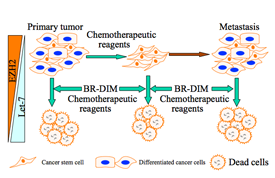BERKELEY, CA (UroToday.com) -
Targeted elimination of cancer stem cells or cancer stem-like cells by BR-DIM is in part mediated through deregulated expression of let-7 and EZH2 in prostate cancer
Prostate cancer (PCa) is the second leading cause of cancer related death in men in the United States, and expected to cause 28,170 deaths in the USA in 2012.(1) Tumor recurrence and metastasis contributes to high mortality of patients diagnosed with PCa, which in part could be attributed to the existence (de novo) and the emergence and enrichment of cancer stem cells (CSCs) or cancer stem-like cells (CSLCs) after treatment. The CSCs or CSLCs are the cells present within a tumor that possess the self-renewal and tumor-initiating capacity, and are also capable to differentiate into the heterogeneous lineages of cancer cells that comprise in a tumor mass. These tumor-initiating cells could provide a reservoir for cells that cause tumor recurrence after therapy and are in part responsible for the emergence of drug-resistant cells. Therefore, optimal therapeutic strategy for PCa treatment should be focused on targeted killing of CSCs or CSLCs which are the “root” cause of tumor recurrence and metastasis.
Mounting evidence suggests that deregulated expression of microRNAs (miRNAs) including the let-7 family contribute to cancer progression and recurrence.(2) Loss of let-7 expression has been found in various cancers, including PCa.(3) Moreover, loss of let-7 has been demonstrated to be associated with poor prognosis of patients diagnosed with lung cancer,(4) head and neck squamous cell carcinoma,(5) and ovarian cancer.(6) Recent studies have also shown that let-7 family regulates the self-renewal capacity of breast cancer cells(7) and PCa cells by regulating the expression of cancer stem cell-related transcription factors such as Oct4, Sox2, and Nanog.(8) These results suggest that the let-7 family could play a key role in the progression of PCa by maintaining and regulating various molecular features of CSCs or CSLCs in PCa; however, how let-7 family contributes to PCa aggressiveness is not known, and thus further in-depth investigations are warranted.
In a recently published article, we found that let-7 family regulates the expression of Enhancer of Zeste homolog 2 (EZH2), which has been demonstrated to control stem cell function. Moreover, we found that let-7 family was decreased with concomitant over-expression of EZH2 in human PCa tissue specimens, especially in higher Gleason grade tumors. The expression of let-7b and let-7c was inversely correlated with EZH2 expression.(9) These results suggest that let-7 family plays a critical role in PCa progression, which is in part mediated through the regulation of EZH2 expression, and thereby regulating the expression of stem cell signature genes. More interestingly, we found that BR-DIM (formulated DIM: 3,3’-diindolylmethane by Bio Response, Boulder, CO, abbreviated as BR-DIM) intervention led to the up-regulated expression of let-7 family with concomitant down-regulation of EZH2 expression in PCa tissue specimens obtained from our on-going phase II clinical trial in patients receiving BR-DIM prior to radical prostatectomy. These results clearly suggest that the loss of let-7 mediated increased expression of EZH2 contributes to PCa aggressiveness, which could be attenuated by BR-DIM treatment (see Figure 1.), and thus BR-DIM would likely serve as a promising agent for designing novel therapeutic strategies for the prevention and/or treatment of PCa.

Figure 1. (Click thumbnail to enlarge)
References:
- Siegel R, Naishadham D, Jemal A. Cancer statistics, 2012. CA Cancer J Clin 2012;62:10-29.
- Peter ME. Let-7 and miR-200 microRNAs: guardians against pluripotency and cancer progression. Cell Cycle 2009;8:843-52.
- Barh D, Malhotra R, Ravi B, Sindhurani P. MicroRNA let-7: an emerging next-generation cancer therapeutic. Curr Oncol 2010;17:70-80.
- Landi MT, Zhao Y, Rotunno M et al. MicroRNA expression differentiates histology and predicts survival of lung cancer. Clin Cancer Res 2010;16:430-41.
- Childs G, Fazzari M, Kung G et al. Low-level expression of microRNAs let-7d and miR-205 are prognostic markers of head and neck squamous cell carcinoma. Am J Pathol 2009;174:736-45.
- Helland A, Anglesio MS, George J et al. Deregulation of MYCN, LIN28B and LET7 in a molecular subtype of aggressive high-grade serous ovarian cancers. PLoS One 2011;6:e18064.
- Yu F, Yao H, Zhu P et al. let-7 regulates self renewal and tumorigenicity of breast cancer cells. Cell 2007;131:1109-23.
- Kong D, Banerjee S, Ahmad A et al. Epithelial to mesenchymal transition is mechanistically linked with stem cell signatures in prostate cancer cells. PLoS One 2010;5:e12445.
- Kong D, Heath E, Chen W et al. Loss of let-7 up-regulates EZH2 in prostate cancer consistent with the acquisition of cancer stem cell signatures that are attenuated by BR-DIM. PLoS One 2012;7:e33729.
Written by:
Dejuan Kong,1 Elisabeth Heath,2 Yiwei Li,1 Seema Sethi,1 and Fazlul H. Sarkar1,2 as part of Beyond the Abstract on UroToday.com. This initiative offers a method of publishing for the professional urology community. Authors are given an opportunity to expand on the circumstances, limitations etc... of their research by referencing the published abstract.
Departments of Pathology, Oncology,2 Karmanos Cancer Institute, Wayne State University School of Medicine, Detroit, Michigan

More Information about Beyond the Abstract


